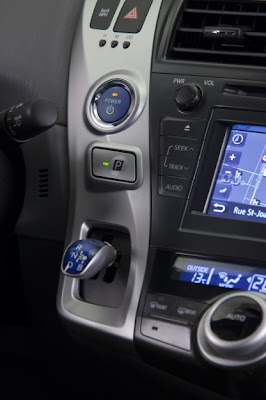 |
| 2012-Toyota-Prius-v-Luxury |
Since its inception in 1997, the Toyota Prius easily has outpaced all other hybrids in terms of pure popularity, with sales worldwide since the launch of the accounts of three million vehicles. While critics of perpetual hybrid and electric vehicles is said to be a proverbial drop in the bucket in terms of vehicle sales, it is always better to be a drop in a bucket and a big fish in a small pond.
 |
| 2012-Toyota-Prius-v-Luxury-inside |
The strength of the vehicle, as expected, is the hybrid propulsion system (shared with the regular Prius), which combines a gasoline engine 1.8-liter four-cylinder with 60 kW of electricity to produce a combination of 100 kW. This couple is linked to a continuously variable transmission and are managed by four different driving modes, ranging from extra-soft slightly spicy. In EV mode the vehicle can run on electricity alone at speeds of about 2 km in the city, while power mode brings (some) added punch.
Let's be clear: The Prius V does not provide an exhilarating driving experience. This is an extremely fast car, it is not particularly attractive, but it does, however, offer a reasonable steering feel, a smooth ride and handling acceptable.
As the Prius is larger than its immediate predecessor, it goes without saying that probably lead to more people (although still a five-seater, like the Prius) and property / or more. In anticipation, Toyota engineers gave the vehicle a redesigned suspension system and an innovative technology called pitch and bounce control. This system uses the torque of the hybrid powertrain to help control the balance of the vehicle in case of acceleration and handling in curves.
Much thought has been devoted to other aspects of the Prius and V. Steel high tensile strength and aluminum is used in key areas to reduce excess weight. And the optional panorama glass roof is constructed of resin, which reduces weight by 38 percent of a glass ceiling of comparable size. Ultimately, the Prius V weighs 105 kg more than the Prius - but taking into account the added value is a small price to pay.
During our test drive in Quebec, Canada - made in the way most of the time, and with the throttle seriously - the display on Prius V suggests an average consumption of 6.0L/100km. Just enough.
But if there is one area where the Prius V particularly disappointing is the lack of cool factor. The Prius hatch has some geek-chic, call it, no, he does not have the silhouette of a sports car, but has enough of a wedge-shaped profile suggests that the aerodynamics have been involved in the design. The Prius also has an angular profile V-shaped, but because it's bigger, it looks like a minivan trying in vain to look cool.
 |
| 2012-Toyota-Prius-v-Luxury-inside |
So, too, has the innovative touch system control marker. A standard feature on the Prius hatch, this technology is the driver to activate the various controls through the gold wheels mounted on the wheel. When the driver touches a section of the wheel, a duplicate image active control that is projected onto the windshield. Thus, the controls can be operated without looking down.
This is a very elegant, but you get used to the word on the street is that the control contact of the marker may have been considered too "young" function for the target market Prius V. Meaning: If you have not grown up with an iPod glued to his hand, touch the control indicator is probably out of your comfort zone.
While the 2012 Toyota Prius V can not be as attractive as the Prius in a visual perspective or technological, is nevertheless an interesting new family vehicle. Even better, with a base price close to the original Prius in some markets - and even cheaper than the other - the Prius V is real value in the segment of hybrids.
Read about 2012 Toyota Prius C Preview.





 Blog RSS Feed
Blog RSS Feed
No comments:
Post a Comment